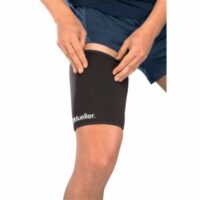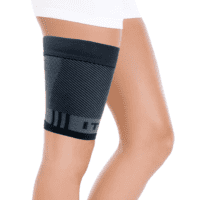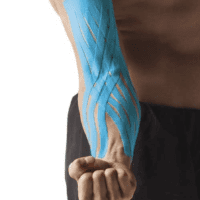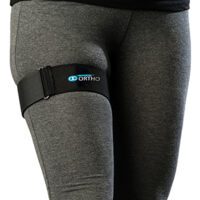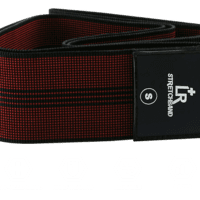Proximal Hamstring Tendinopathy
Article by Zoe Russell

Proximal Hamstring Tendinopathy
What Is Proximal Hamstring Tendinopathy?
Proximal Hamstring Tendinopathy (PHT), commonly known as high hamstring tendinopathy, is an injury to the hamstring origin tendon. This injury occurs where the tendon attaches to the pelvis’s ischial tuberosity and often results in gluteal pain. Repetitive strain or overuse of the hamstring muscles typically causes the condition.
Who Does It Affect?
Athletes who engage in activities with repetitive hip extension, like running, sprinting, and soccer, frequently experience proximal hamstring tendinopathy. Manual labourers and gardeners are also susceptible due to the nature of their work, which often involves bending and lifting.
Symptoms and Causes of Proximal Hamstring Tendinopathy

Identifying the Symptoms
The condition usually develops as a gradual onset of pain, presenting as a deep, dull ache in the buttocks that worsens with specific activities. The pain may extend down the thigh, following the hamstring muscle path, and is often linked with activities that stress the hamstring muscles.
Understanding the Causes
High hamstring tendinopathy stems from the repetitive strain on the hamstring muscles, leading to tendon degeneration and inflammation. When the tendons are overloaded beyond their capacity to adapt and heal, this can lead to pain and a decreased ability to withstand activity.
Risk Factors and Phases of Tendinopathy
Recognising Risk Factors
Several factors can increase the likelihood of developing high hamstring tendinopathy. These include previous hamstring injuries, muscle strength loss, poor gluteal function, and an imbalance in pelvic alignment. Both intrinsic and extrinsic factors, such as training loads and equipment, play a role.
Phases of Tendinopathy
The condition progresses through several stages, starting with reactive tendinopathy, marked by pain and swelling, progressing to tendon dysrepair with ongoing degeneration, and possibly leading to a degenerative state where extensive tissue damage occurs. Read more: Tendinopathy Phases
Diagnosis and Treatment Strategies
How to Diagnose It
Diagnosing proximal hamstring tendinopathy involves a combination of patient history, physical examination, and, when necessary, imaging tests like MRI to confirm the diagnosis and assess the extent of the injury.
Effective Treatment Approaches
Treatment typically includes a combination of exercise therapy, load management, and pain management. A physiotherapist will tailor a rehabilitation plan, employing pain provocation tests to gauge recovery and determine when to resume sports safely.
Managing Exercise Load and Rehabilitation
Prioritising Load Management
Successful treatment hinges on managing activity loads to stimulate tendon growth without overloading. Physiotherapists may employ a traffic light system to help patients gauge the safe level of activity.
Progressing Through Rehabilitation
A patient’s prognosis with proximal hamstring tendinopathy can vary. Early and consistent treatment often leads to a complete recovery, whereas advanced cases may require extended rehabilitation.
Exercises and Adjacent Treatments
Selecting the Right Exercises
Avoiding exercises that trigger pain is critical. As recovery progresses, specific strengthening exercises, particularly eccentric ones, can be highly beneficial when introduced at the right time under a physiotherapist’s supervision.
Exploring Adjacent Treatments
Addressing lower limb biomechanical issues is part of comprehensive treatment. Additionally, novel therapies, such as injections, may be considered for some patients, though these require further validation.
Conclusion
Each case of proximal hamstring tendinopathy is unique, necessitating a personalised approach to rehabilitation. Consulting a qualified physiotherapist is crucial to design an effective treatment plan tailored to the individual’s specific needs.
Related Articles
- Hamstring Pain: Offers insights into various hamstring injuries, highlighting their similarities and differences with Proximal Hamstring Tendinopathy.
- Tendinopathy: Causes, Symptoms, And Effective Treatments: Discusses the broader category of tendinopathies, providing a deeper understanding of tendon injuries.
- Hamstring Strain: Details on hamstring strains, a common issue among athletes, which could be relevant for understanding hamstring health.
- Tendinopathy Phases: Explains the different stages of tendinopathy, offering a deeper dive into how these conditions progress and are managed.
- Common Tendinopathies: An Overview of Tendon Injuries: A comprehensive look at various tendinopathies, placing Proximal Hamstring Tendinopathy in a broader context.
- Piriformis Syndrome: Although focusing on a different condition, this article can help differentiate between hamstring-related pain and other similar conditions.
- Greater Trochanteric Pain Syndrome (GTPS): Discusses hip and groin pain, which might be relevant given the proximity to the hamstring area.
- Hip Adductor Tendinopathy: Provides insights into another tendinopathy in the hip area, which could be mistaken for or occur alongside hamstring issues.
- Gluteal Tendinopathy: Offers information on tendinopathy affecting the glutes, a region closely related to the hamstring.
Article by John Miller
Thigh Injuries
Thigh injuries can significantly impact your daily life and activities, whether you're an athlete or someone who enjoys staying active. As a physiotherapist, I often encounter individuals seeking assistance for various lower body ailments. In this guide, I'll discuss the most common thigh injuries, their causes, prevention strategies, and when to seek professional advice.


Common Thigh Injuries
- Thigh injuries encompass a range of conditions, including muscle strains and contusions. These injuries often occur during sports activities, sudden movements, or accidents. Symptoms may include pain, swelling, bruising, and difficulty moving the affected leg.
- A hamstring strain involves damage to one or more of the muscles at the back of the thigh. This injury is prevalent among athletes, particularly those involved in sports requiring sprinting, jumping, or sudden changes in direction. Symptoms include sharp pain, tenderness, and weakness in the hamstring muscles.
- Iliotibial band syndrome, or ITB syndrome, is a common overuse injury among runners and cyclists. It occurs when the ITB, a thick band of tissue running along the outside of the thigh, becomes inflamed or irritated. Symptoms typically include pain on the outer side of the knee, especially during activities such as running or cycling.
- Runner's knee, also known as patellofemoral pain syndrome, is a common complaint among runners, cyclists, and individuals who engage in repetitive knee movements. It causes pain around or behind the kneecap, often exacerbated by activities such as climbing stairs, squatting, or sitting for prolonged periods.
- Sciatica refers to pain that radiates along the path of the sciatic nerve, which runs from the lower back through the hips and down each leg. It can result from various factors, including a herniated disc, spinal stenosis, or muscle tightness. Symptoms may include sharp or burning pain, numbness, tingling, and weakness in the legs.
Prevention Strategies
Preventing lower body injuries begins with understanding the risk factors and implementing proactive measures. Here are some strategies to help you safeguard your lower body health:
- Warm-up and Cool-down: Incorporate dynamic warm-up exercises before physical activity to prepare your muscles and joints for movement. Follow up with gentle stretching and cool-down exercises to aid in muscle recovery and flexibility.
- Gradual Progression: Avoid overexertion by gradually increasing the intensity, duration, and frequency of your workouts. Sudden spikes in activity level can increase the risk of injury, so listen to your body and progress at a pace that feels comfortable.
- Proper Technique: Ensure proper form and technique during exercise to minimise the risk of strain or injury. Consult with a qualified fitness instructor or physiotherapist to learn correct movement patterns and modifications tailored to your needs.
- Strength and Flexibility: Incorporate strength and flexibility exercises targeting the muscles surrounding your thighs, hips, and knees. Focus on exercises that improve stability, balance, and range of motion to support your lower body joints during physical activity.
- Rest and Recovery: Allow for adequate rest and recovery between workouts to prevent overuse injuries and promote muscle repair. Listen to your body's cues and avoid pushing through pain or fatigue, as this can lead to further injury.
Conclusion
By prioritising prevention strategies and seeking professional guidance when needed, you can minimise the risk of experiencing debilitating lower body injuries. Remember to listen to your body, respect its limits, and invest in its long-term health and functionality.
What to Do?
If you're experiencing persistent pain or discomfort in your lower body, it's essential to seek the guidance of a qualified physiotherapist. They can assess your condition, provide targeted treatment, and develop a tailored rehabilitation plan to help you recover safely and effectively.
Related Articles
- Understanding and Treating Thigh Injuries
- Preventing Hamstring Strains: Tips and Exercises
- Managing ITB Syndrome: Effective Treatment Strategies
- Runner’s Knee: Causes, Symptoms, and Treatment
- Sciatica Relief: Exercises and Therapies
- Lower Body Strengthening Exercises for Injury Prevention
- The Importance of Warm-up and Cool-down for Athletes
- Understanding Overuse Injuries in Sports
- Effective Strategies for Rest and Recovery
- When to Seek Physiotherapy for Sports Injuries








